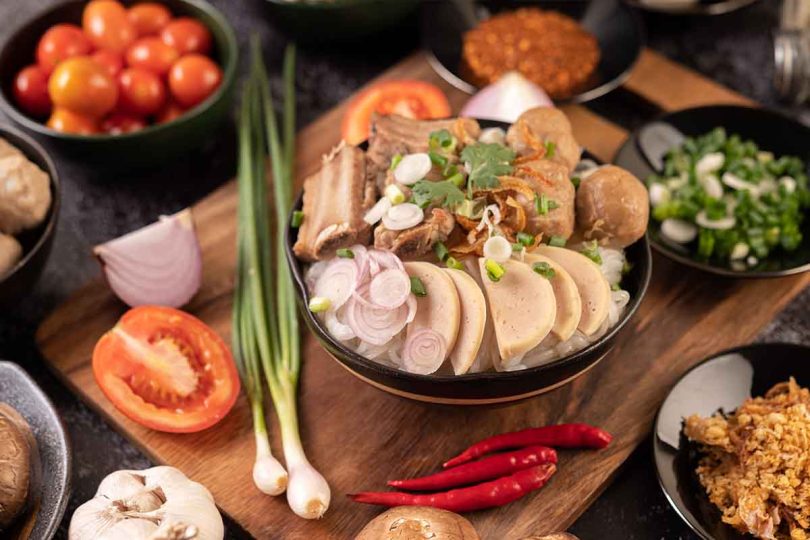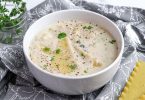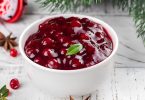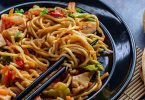Traditional Vietnamese cuisine is nutritious. Meals are heavy on rice, veggies, and seafood, and cooking methods are frequently steaming or stir-frying.
Rice is the diet’s foundation, appearing in some form at practically every meal. All three meals of the day for Vietnamese adults typically consist of steamed rice with side dishes of vegetables, fish, or meat. They steamed rice variations with ground pork, bean sprouts, and basil.
Do you want to learn how to make Vietnamese food at home? Then this is the guide for you.
Before we go any further, let’s take a moment to think about what you’ll need to cook most Vietnamese dishes, how to get the right ingredients, where to find them, and more.
If you wish to purchase some of these things, you need first look for an Asian or specialty grocer near you, as they may not be available at every supermarket.
fish sauce:
In practically every Vietnamese household, a dinner is incomplete without fish sauce. In Vietnam, this sauce is known as nuoc cham. So, if you want to learn Vietnamese cuisine, this is a must.
oyster sauce:
This nearly-syrupy sauce is produced by boiling boiled oysters and extracting an essence, blended with sugar, water, and thickened with cornstarch. It’s a sweet but savory, almost caramelly sauce that works well with sautéed vegetables and spreads well over any cuisine. This is a common ingredient in Southeast Asian cooking, and you may have seen it more than one time. It will be used to reduce any bitterness caused by leafy greens in your Vietnamese recipes and give sweetness to beef cubes.
the banana blossom:
Before bananas can be picked, the banana blossom or flower is harvested. To begin, remove the outer purple leaves and buds. The flower is cut in half and very thinly sliced into lemon or lime water to prevent discoloration. The chopped flower can then be added to various hot and cold foods and salads.
rice and noodles:
You’ll find everything from wheat to rice to bean noodles in Vietnamese cuisine. If you can’t find them in your store’s global foods aisle, look in the gluten-free or health food department.
Vietnamese cuisine has a wide variety of proteins, including tofu, beef, pork, and shrimp, occasionally used interchangeably.
Tofu:
Although there are some significant differences, Vietnamese cuisine is comparable to Chinese cuisine. Vietnamese cuisine adds lemongrass and mint leaves into numerous meals and a lot of fish sauce and fermented shrimp paste, which flavors each dish distinctively.
Crab Soup:
Tôm chu, or crab soup, is one of Vietnam’s most popular foods. This soup is popular throughout the country and is made with crab, lettuce, herbs, and rice noodles. In this recipe, the crab can be steamed or boiled. Another popular meal is bn riêu or clear broth noodle soup with seafood and vegetables. This meal is served with rice noodles and fried shallots on top.
Kitchen Equipment:
A large pot, a grill pan or outside grill, and a skillet are standard cooking utensils.
After you’ve tried a few dishes, you might find you need to improve some of your cooking equipment. In that scenario, we recommend a carbon steel wok, which is light and conducts heat efficiently, and a simple bamboo steamer.
Standard Vietnamese cooking method:
Steaming:
Food can be steamed on woven bamboo, or metal trays placed one on top of the other. This method is commonly used to prepare sticky rice or shellfish. This method allows you to keep the nutrition in your dishes while also providing free-oil healthy food for your family.
Fried foods:
In Vietnamese meals, as in most Asian countries, the meats are deep-fried for a crispy outer coating before being stir-fried with veggies and seasonings. This process necessitates the use of additional oil and high temperatures.
Stewing:
This method is used for cooking meat with herbs and seasonings. Traditionally, stewed foods are cooked in an earthenware pot for an extended period until the meat becomes tender in texture.
Boiling:
Because of its freshness and healthiness, this approach is used to prepare various foods. Usually, after boiling the vegetables, individuals save the water to make vegetable soup for their families.
Stir-fry:
This technique is mostly used for vegetables and mushrooms; however, chefs occasionally combine them with meat and fish sauce. It calls for high heat, fast pan-searing, and stir-frying.
Grilling:
This method is used to make a range of foods, including skewered dishes cooked in bamboo tubes over the fire, char-grilled over an open fire; wrapped in banana leaves, and grilled; grilled marinated meat, grilled then topped with melted lard, peanuts, and chopped green onions.
Fresh wrapping:
This procedure is quite simple, yet it adds a wonderful healthful flavor to the food. Broil all vegetable components, wrap rice paper, and serve with dipping sauces.








Leave a Comment